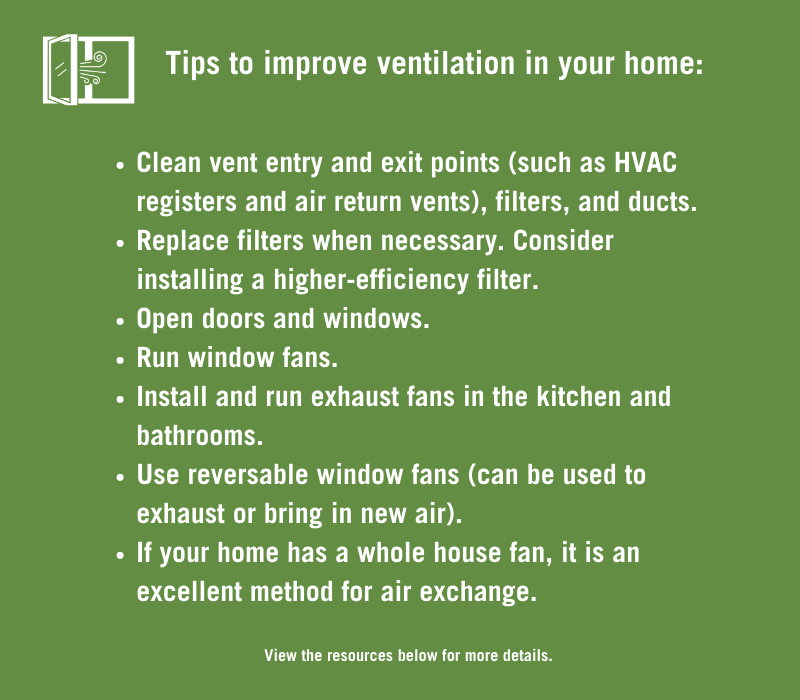Healthy Homes Guide to Cleaning and Disinfection
Ventilation
Para la página en español, visite Ventilación.
Another important way to help control the spread of COVID-19 and other infectious diseases that can spread through the air is to ensure good ventilation and exchange of indoor air. Increased ventilation can reduce the amount or concentration of contaminants and virus particles in the air. This is just as important as cleaning, disinfecting, and social distancing and should be used in conjunction with those practices.
Good ventilation is also important for reducing the hazards of using certain cleaning products. Visit our Products page to read more about using products safely.
Definitions
Ventilation refers to air exchange, both bringing new air inside a building and removing old air. There are different ways to accomplish this:
- Mechanical ventilation is exchanging air using fans.
- Natural ventilation is exchanging air without fans, through openings including doors and windows.
- Mixed-mode ventilation systems use both mechanical and natural ventilation.
It’s important to understand that there are many factors that influence how well air exchange will work. For example, which doors and windows are open and whether they create any cross-draft in the house will influence how much air moves through the home. It’s also important to keep outdoor air quality in mind when deciding how to adjust your home’s ventilation. If you live somewhere with poor outdoor air quality, you may need to reduce the amount of air you are bringing into the home from outside.

For Homes
A note for renters: Ventilation can be more difficult in a rental residence as you may not have control over an HVAC system depending on the setup of your home or building. However, even if adjusting the mechanical ventilation is unavailable to you, there are several ways that you can use natural ventilation to increase air exchange. We’ve marked the sections of the resources below that may be more applicable to renters, homeowners, or property managers.
Interactive Home Ventilation Tool
For renters and homeowners: CDC’s interactive website allows users to see how particle levels change as you adjust the ventilation settings in your home. [url; CDC, 2022]
Indoor Air in Homes and COVID-19
For renters and homeowners: This EPA web page is a good place to start with some basic steps for increasing ventilation in your home. They cover the following topics:
- How to increase ventilation by opening doors and windows or by using fans.
- How to use your heating, ventilation, and air conditioning (HVAC) system effectively.
- Using a portable air cleaner or air purifier.
- When to use evaporative coolers and whole-house fans.
ASHRAE Resources
The American Society of Heating, Refrigerating and Air-Conditioning Engineers (ASHRAE) also has several resources for residents and property managers:
- Residential Guidance
For renters (especially pages 4-5), homeowners, and property managers (especially page 7): This presentation includes the following general guidance:- Maintain your normal thermal comfort conditions
- Increase ventilation
- Operate exhaust fans in bathroom
- Use stand-alone air cleaners if available
- Increase air movement (through use of fans)
The presentation provides additional specific guidance if you have a forced-air system, are operating a multifamily building, and for creating an isolation space for infected individuals or a protected space for high-risk individuals.
- Residences FAQ
Applicable to all audiences: This FAQ covers questions about a bunch of topics, including how to use and adjust different forced-air systems and how to reduce risks. Questions about specific systems include example pictures for clarification. It also includes a glossary of ventilation terms. - Filtration FAQ
Primarily homeowners and property owners: This FAQ covers questions about HVAC systems, including filter use and disinfecting.
For Workplaces and Schools
REHVA COVID-19 Guidance
This resource from the Federation of European Heating, Ventilation and Air Conditioning Associations (REHVA) is aimed at using building services to reduce risk in workplaces. It makes the following recommendations:
- Increase air supply and exhaust ventilation
- Use more window airing
- Adjust use of heat recovery sections
- Do not use recirculation
- Room air cleaners can be useful in specific situations
- Flush toilets with closed lids
Reoccupying
This section of the ASHRAE FAQ includes guidance on re-occupying a building that has been shut down, with specific information for schools and universities.
EPA: Healthy Indoor Environments in Schools
This page from EPA includes a link to an Indoor Air Quality Tools for Schools Action Kit, which includes reference guides, fact sheets, and checklists. The page also links to specific guidance from EPA and others on COVID-19.
